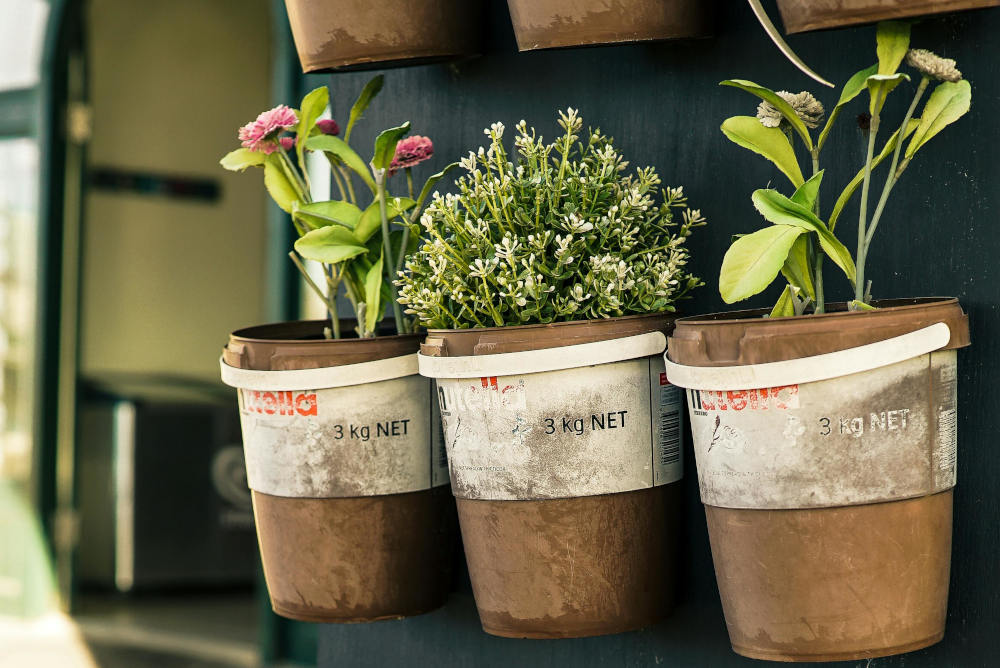
Les herbes aromatiques comptent parmi les plantes les plus faciles et les plus gratifiantes à cultiver, que ce soit en pot sur un rebord de fenêtre ou dans un massif de votre jardin. Mais l'une des questions les plus fréquentes des jardiniers débutants (et même expérimentés) est : à quelle distance peut-on planter des herbes aromatiques ?
Il n'existe pas de solution universelle. Cela dépend des types d'herbes aromatiques, de leur mode de culture (en pots, en massifs surélevés ou en pleine terre) et de vos priorités : rendement, esthétique ou aération. Planter des herbes aromatiques trop près les unes des autres peut entraîner un surpeuplement, une mauvaise croissance et des problèmes fongiques. En revanche, les espacer trop les unes des autres gaspille un espace de culture précieux.
Cet article explore l'espacement idéal des herbes aromatiques courantes, leur regroupement par mode de croissance, les méthodes de jardinage et les meilleures pratiques de compagnonnage. À la fin, vous saurez exactement comment organiser votre jardin d'herbes aromatiques pour des plantes saines et productives.
Panaprium est indépendant et pris en charge par les lecteurs. Si vous achetez quelque chose via notre lien, nous pouvons gagner une commission. Si vous le pouvez, veuillez nous soutenir sur une base mensuelle. La mise en place prend moins d'une minute et vous aurez un impact important chaque mois. Merci!
Pourquoi l'espacement est important
L'espacement des plantes n'est pas seulement une question d'esthétique : il influence la santé globale de votre jardin. Voici pourquoi il est important de laisser suffisamment d'espace aux herbes aromatiques :
-
Circulation de l'air : Prévient les maladies fongiques et la moisissure, en particulier dans les climats humides.
-
Accès à la lumière du soleil : les herbes trop serrées s'ombragent les unes les autres, ce qui réduit la croissance.
-
Développement des racines : les herbes ont besoin d’espace pour développer des systèmes racinaires solides, qui favorisent des récoltes plus importantes et de meilleure qualité.
-
Lutte antiparasitaire : Certains nuisibles prospèrent dans des environnements denses et humides. Un espacement adéquat les en dissuade.
Directives générales d'espacement
Commençons par un aperçu général. Voici un bref aperçu des besoins d'espacement typiques des herbes populaires :
| Herbe | Espacement (pouces) | Habitude de croissance |
|---|---|---|
| Basilic | 10–12 | Touffu, dressé |
| Persil | 6–8 | Formation de touffes |
| coriandre | 6–8 | Tiges dressées et souples |
| ciboulette | 4–6 | Agglutinant, semblable à de l'herbe |
| Origan | 10–12 | Tentaculaire, à croissance lente |
| Thym | 8–12 | Base étalée et boisée |
| Menthe | 12–18 (ou isolé) | Épandeur agressif |
| Romarin | 12–24 | Arbuste érigé et ligneux |
| Sage | 12–18 | Base ligneuse, sommet touffu |
| Aneth | 12 | Grand, plumeux |
| Estragon | 12–18 | Tiges dressées et ligneuses |
Voici des indications d'espacement moyen pour les massifs extérieurs . Dans des pots ou des espaces plus petits, vous pouvez planter les herbes aromatiques un peu plus près ; prévoyez simplement une taille et un entretien plus fréquents.
À quelle distance peut-on planter des herbes dans des conteneurs ?
La culture en conteneurs est plus efficace en termes d'espace, mais elle a ses propres règles. En pot, les principales préoccupations sont la concurrence racinaire et la circulation de l'air .
Règle générale :
Laissez au moins 6 à 8 pouces d’espace entre les petites herbes et 10 à 12 pouces pour les herbes plus grosses.
Recommandations concernant la taille des pots :
-
Pots de 6 à 8 pouces : Convient pour une herbe (comme le thym, la ciboulette ou le persil)
-
Pots de 10 à 12 pouces : peuvent contenir deux petites herbes compatibles
-
Pots ou jardinières de 14 à 18 pouces : peuvent contenir 3 à 4 herbes, selon leur taille et leur taux de croissance
Conseils pour une plantation rapprochée en pots :
-
Associez des herbes ayant des besoins similaires en eau et en soleil
-
Utilisez un sol léger et bien drainé pour éviter la pourriture dans les espaces restreints
-
Taillez régulièrement les herbes aromatiques pour éviter le surpeuplement
-
Choisissez des herbes ayant des habitudes de croissance différentes (par exemple, une dressée, une rampante)
Espacement par catégorie d'herbes
🌿 Herbes tendres à croissance rapide (par exemple, basilic, persil, coriandre)
Ces herbes poussent rapidement, ne deviennent pas très ligneuses et peuvent tolérer un espacement plus serré.
-
Espacement idéal : 6 à 10 pouces
-
Planter serré, c'est possible ? Oui, surtout pour la récolte par coupes successives.
🌱 Astuce : Pour le basilic, pincez régulièrement les fanes pour garder la plante compacte lorsque l'espace est restreint.
🌿 Plantes vivaces ligneuses (par exemple, romarin, sauge, origan, lavande)
Ces herbes poussent en formes plus grandes et touffues et peuvent devenir des éléments permanents dans un jardin.
-
Espacement idéal : 12 à 24 pouces
-
Planter serré, c'est possible ? Non recommandé. Ces herbes ont besoin d'espace pour la circulation de l'air et le développement des racines.
🌱 Astuce : si l'espace est limité, cultivez-les dans des contenants individuels pour éviter le surpeuplement.
🌿 Épandage d'herbes (par exemple, menthe, mélisse)
Ces herbes peuvent être envahissantes, envoyant des stolons et envahissant rapidement les plates-bandes.
-
Espacement idéal : 12 pouces ou plus, ou isoler dans des conteneurs
-
Plantation serrée autorisée ? Seulement si entièrement contenue.
🌱 Astuce : Cultivez la menthe en pot, même en pleine terre, en enfonçant le pot dans le sol pour contenir les racines.
🌿 Herbes agglomérantes (par exemple, ciboulette)
Ces herbes poussent en touffes serrées et peuvent tolérer un espacement modéré.
-
Espacement idéal : 4 à 6 pouces
-
Planter serré, c'est possible ? Oui, surtout en conteneur.
🌱 Astuce : Divisez les touffes de ciboulette tous les 1 à 2 ans pour maintenir leur vigueur.
Espacement dans les plates-bandes surélevées et les jardins en pleine terre
Dans les plates-bandes surélevées :
-
Les herbes peuvent être plantées légèrement plus près qu'en pleine terre en raison d'un meilleur drainage et d'une meilleure qualité du sol.
-
Prévoyez 6 à 8 pouces entre les petites herbes et 12 à 18 pouces pour les plus grosses
Jardins creusés :
-
Restez fidèle aux directives d'espacement standard
-
Prévoyez plus d'espace pour étaler des herbes comme la menthe et l'origan
-
Envisagez d’utiliser des barrières physiques pour gérer les propagateurs agressifs
🌱 Exemple de plan :
Dans un lit surélevé 4x4, vous pourriez confortablement planter :
-
2 buissons de romarin (coins diagonaux)
-
4 à 6 plants de basilic (au centre)
-
3 plants de thym (bordures)
-
2 touffes de ciboulette (sur le devant)
Que se passe-t-il si vous plantez des herbes trop près ?
Bien qu'il soit tentant de presser des herbes ensemble pour obtenir un aspect luxuriant, voici ce qui peut mal se passer :
🚫 Mauvaise circulation d'air
L’humidité reste emprisonnée, ce qui entraîne l’oïdium ou la pourriture des racines, en particulier dans le basilic, l’origan et la sauge.
🚫 Récolte réduite
Les herbes trop denses poussent plus lentement et produisent moins de feuilles, en particulier les variétés exigeantes en lumière comme l'aneth et le romarin.
🚫 Augmentation des maladies et des ravageurs
Les feuilles et les tiges qui se chevauchent créent des cachettes pour les pucerons, les tétranyques et les spores fongiques.
🚫 Concours de racines
Les herbes à racines peu profondes comme la coriandre peuvent être supplantées par des types à racines plus profondes comme le romarin si elles sont plantées trop près.
Compagnonnage : regrouper les herbes qui poussent ensemble
Toutes les herbes aromatiques ne craignent pas d'être proches ; certaines bénéficient même d'être plantées ensemble. Lorsque vous regroupez des herbes aromatiques, privilégiez les besoins communs (ensoleillement, type de sol, fréquence d'arrosage).
🌿 Bonnes herbes compagnes :
-
Basilic + Persil + Ciboulette : Tous apprécient un sol humide et riche et le soleil.
-
Thym + Origan + Romarin : herbes méditerranéennes qui aiment les sols secs et le soleil.
-
Menthe + Mélisse : Il est préférable de conserver les deux variétés dans leur propre espace, mais elles peuvent être cultivées ensemble dans un grand pot.
🚫 Herbes qui ne se mélangent pas bien :
-
Fenouil : Libère des composés qui inhibent la croissance de nombreuses herbes.
-
Herbes de la famille de l'aneth et de la carotte (par exemple, la coriandre, le persil) : peuvent se polliniser de manière croisée ou entrer en compétition.
-
Menthe + Autre chose (en pleine terre) : Trop agressif, planter seul.
Jardinage vertical et murs d'herbes aromatiques
Manque d'espace ? Les jardins d'herbes aromatiques verticaux et les jardinières murales sont des solutions tendance. Ces systèmes permettent de planter les herbes plus près les unes des autres, mais la circulation de l'air et le drainage sont essentiels.
-
Laissez 4 à 6 pouces entre les petites herbes dans les jardinières verticales
-
Utilisez des contenants respirants (comme des poches en feutre) avec un bon drainage
-
Placez les herbes plus grosses comme le romarin au fond , où plus d'espace racinaire et d'eau s'accumulent
Comment ajuster l'espacement au fil du temps
Les herbes aromatiques ne poussent pas toutes au même rythme. Commencez par un espacement plus serré pour les semis, puis éclaircissez si nécessaire.
Conseils:
-
Semis : Plantez à 2–3 pouces de distance et éclaircissez jusqu'à l'espacement final
-
Transplantations : utiliser un espacement complet dès le début
-
Tailler régulièrement : permet de contrôler les plantes lorsque l'espacement est serré
-
Récoltez stratégiquement : utilisez les feuilles des zones encombrées pour améliorer l'accès à la lumière
Réflexions finales : trouver le juste milieu
Alors, à quelle distance pouvez -vous planter des herbes aromatiques ? La réponse dépend de votre style de jardinage, de vos choix d'herbes aromatiques et de vos objectifs.
En règle générale :
-
Dans les plates-bandes , respectez un espacement de 6 à 18 pouces selon la taille des herbes.
-
Dans les conteneurs , vous pouvez aller un peu plus près, notamment avec une taille régulière
-
Dans les espaces restreints , choisissez des herbes qui tolèrent la promiscuité (comme la ciboulette, le persil, la coriandre)
-
Les propagateurs agressifs comme la menthe doivent être isolés
Un espacement intelligent prévient non seulement le stress des plantes, mais stimule également votre récolte et permet à votre jardin d'herbes aromatiques de prospérer tout au long de la saison.
Tableau de référence rapide : résumé de l'espacement des herbes
| Herbe | Espacement minimal (pouces) | Cultivé de préférence en | Peut-il tolérer une plantation plus rapprochée ? |
|---|---|---|---|
| Basilic | 10–12 | Conteneurs, plates-bandes surélevées | Oui, avec la taille |
| Persil | 6–8 | Plates-bandes surélevées, conteneurs | Oui |
| coriandre | 6–8 | Pots, lits | Oui |
| ciboulette | 4–6 | Conteneurs, bordures de jardin | Oui |
| Menthe | 12–18 (solo) | Conteneurs isolés | Non |
| Origan | 10–12 | Lits, grands pots | Quelque peu |
| Thym | 8–12 | Rocailles, massifs | Quelque peu |
| Romarin | 12–24 | Grands pots, en pleine terre | Non |
| Sage | 12–18 | Lits, grands conteneurs | Non |
Cet article vous a-t-il été utile ? S'il vous plaît dites-nous ce que vous avez aimé ou n'avez pas aimé dans les commentaires ci-dessous.
About the Author: Alex Assoune
Contre Quoi Nous Luttons
Les groupes multinationaux surproduisent des produits bon marché dans les pays les plus pauvres.
Des usines de production où les conditions s’apparentent à celles d’ateliers clandestins et qui sous-payent les travailleurs.
Des conglomérats médiatiques faisant la promotion de produits non éthiques et non durables.
De mauvais acteurs encourageant la surconsommation par un comportement inconscient.
- - - -
Heureusement, nous avons nos supporters, dont vous.
Panaprium est financé par des lecteurs comme vous qui souhaitent nous rejoindre dans notre mission visant à rendre le monde entièrement respectueux de l'environnement.
Si vous le pouvez, veuillez nous soutenir sur une base mensuelle. Cela prend moins d'une minute et vous aurez un impact important chaque mois. Merci.































0 commentaire